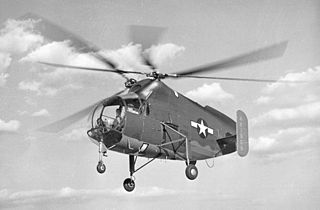The Aer Lualdi L.55 was a prototype Italian helicopter, a development of the Lualdi-Tassotti ES 53 featuring a far more powerful 134 kW (180 hp) Lycoming O-360. While the ES 53 had been purely experimental, the L.55 was Lualdi's first step towards a marketable aircraft.

The Aerfer Sagittario 2 was a prototype all-metal single-seat lightweight fighter aircraft built in Italy by Aerfer, intended to serve as an interceptor or light tactical support aircraft. First flown in 1956, it became the first Italian aircraft to break the sound barrier in controlled flight when it reached Mach 1.1 during a dive from 13,725 m (45,000 ft).

The Hiller YH-32 Hornet was an American ultralight helicopter built by Hiller Aircraft in the early 1950s. It was a small and unique design because it was powered by two Hiller 8RJ2B ramjet engines mounted on the rotor blade tips which weigh 13 lb (5.9 kg) each and deliver an equivalent of 45 hp (34 kW) for a total of 90 hp (67 kW). Versions of the HJ-1 Hornet were built for the United States Army and the United States Navy in the early 1950s.

The Kaman HH-43 Huskie is a helicopter with intermeshing rotors used by the United States Air Force, the United States Navy and the United States Marine Corps from the 1950s until the 1970s. It was primarily used for aircraft firefighting and rescue in the close vicinity of air bases, but was later used as a short-range overland search and rescue aircraft during the Vietnam War.

The Westland Widgeon was a helicopter developed by Westland Aircraft as a private venture improvement on the Westland WS-51 Dragonfly.

The MKEK-4 Uğur was a basic trainer aircraft which was used by the Turkish Air Force between 1955-1963. Originally developed as the THK-15, in total 57 Uğurs were produced in Turkey, all of which were used in the Turkish AF Flight School except three which were donated to the Royal Jordanian Air Force.

The Agusta A.101 was a large prototype transport helicopter developed in Italy during the 1960s. Despite prospective orders from the Italian armed forces, no buyers emerged and the project was abandoned in 1971.

The Agusta AZ.8L, or Agusta-Zappata AZ.8L, was an Italian airliner prototype first flown on 9 June 1958. It was of conventional low-wing monoplane configuration with tricycle undercarriage and all-metal construction. Filippo Zappata's design grew out of a twin-engined transport designated AZ.1 that was never built.

The BŻ-4 Żuk, formerly known as GIL-4, was a Polish four-seat light helicopter built in the 1950s. Although it pioneered a novel rotor and transmission system, it never entered series production.

The NHI H-3 Kolibrie was a small helicopter developed in the Netherlands in the 1950s by Nederlandse Helikopter Industrie. It first flew in May 1956.
The Fiat Model 7002 was a 1960s Italian general-purpose helicopter with a tip jet driven rotor built by Fiat Aviazione. Only one aircraft was built.
The Kamov Ka-126 is a Soviet light utility helicopter with co-axial rotors. Evolved from Ka-26 with engine pods removed from stub wings, fitted with one TVO-100 turboshaft engine positioned on top of fuselage, modified rotor blades, new fuel system.

The Bensen B-7 was a small rotor kite developed by Igor Bensen in the United States in the 1950s and marketed for home building. It was a refined to be a slightly larger version of the B-6, replacing the skids with a tricycle undercarriage, and adding a single large fin to the rear of the aircraft.

The Kellett XR-8 was a helicopter built in the United States during World War II. It was a two-seat machine intended to demonstrate the feasibility of a twin-rotor system, and while it accomplished this, it also demonstrated a number of problems that prevented further development of this particular design.
The THK-5 was a twin-engine aircraft designed by Stanisław Rogalski and built in Turkey in 1945 as an air ambulance. It was a conventional, low-wing cantilever monoplane of wooden construction throughout. The main units of the tailwheel undercarriage retracted into the wing-mounted engine nacelles and the THK-5 could carry two stretcher cases plus a medical attendant. This was followed in production by a six-seat utility transport version designated THK-5A and three examples of an improved version of the 5A designated THK-10. A single example of the type was exported, sold to Denmark.
The Nord 1750 Norelfe was a 1950s French three-seat helicopter built by Nord Aviation and designed by Jean Cantinieau.

The Curtiss-Wright VZ-7 was a VTOL quadrotor helicopter aircraft designed by the Curtiss-Wright company for the US Army. Like the Chrysler VZ-6 and the VZ-8 Airgeep it was to be a "flying jeep".
The Goodyear GA-400R Gizmo was a one-man helicopter proposed for duties such as liaison and observation.

The IAR-811 was a Romanian trainer aircraft built in the late 1940s. It was the first aircraft designed and built in Romania following the end of the Second World War.
The Hurel-Dubois Miles HDM.105 was a transport aircraft fitted with very high aspect ratio wings for research purposes, building on research carried out with the Hurel-Dubois HD.10, and a stepping point to the planned production HDM.106 Caravan. The HDM.105/HDM.106 provided the starting point for the design of the Short SC.7 Skyvan.












